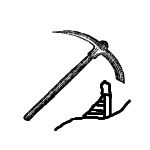Methodology and Experience
This exhibit was made as a final project for HIS4135: Seminar in Canadian History, Canada's Material Past in the Digital Era. The original idea that I had for this project was to cover the evolution of mining equipment and the ways with which the miners influenced their progression in relation to safety. This, however, did not pan out as I had hoped to with the online sources available. Though this idea did not come to fruition, the relationship between companies and their workers and communities continued to intrigue me. That is how I began to look at the mining companies’ effects on the material culture of my hometown of Timmins, Ontario specifically.
Accessibility of information is important to me, especially in the way I convey this project. That is why I decided to do an Omeka digital exhibition rather than a traditional paper. This way the information is in a more digestible form that allows for more people to read and engage with these ideas. Using Omeka I was also able to engage with the sources in a more meaningful way as I delved into the different descriptive ways to identify materials. I originally was very ambitious in what I wanted to include in this project, but quickly became aware of both the limitations of the platform and my personal abilities. I had some problems with inputting some of the external embedded elements that I was looking to add in a way that worked with the rest of the project, so I ended up leaving them out to focus on the rest of the project. Overall, my experience with using Omeka went smoothly though, and I enjoyed exploring a new way of digitally displaying information.
In thinking about the ways in which I went about creating this project from a methodological standpoint, I focused on some key writings to guide my process. In making this into a digital project, the work of Daniel J. Cohen and Roy Rosenzwieg’s work “Digital History: A Guide to Gathering, Preserving, and Presenting the Past on the Web.” This web project provides insights into the making of a purposeful history-based project online in the way that you present information. In particular, I looked to their work for ways of making my information accessible and foster engagement through digital collections.(1) Though I do not think that my exhibit is solely a historical account for a single community, I hope that it can act as a step for having the community think about their history in an academic context. At the same time, I hope I have been able to show a broader online audience what a Northern Ontario mining community has to offer to a larger historical theme.
In terms of the material history methodology, the approaches of Smith et al.’s “Towards a Material History Methodology,” and Prown’s “Mind in Matter: An Introduction to Material Culture Theory and Method.” These writings informed how I approached selecting materials that I could use for this project, going beyond just objects that can be held in your hands and including looking at altered landscapes as material culture.(2) They also provided a framework for processing the data of the materials I was looking at; whether it be observable, comparable, or supplementary data.(3) Elements like the construction, function, provenance, and value of the material became very important for this project. Every part there was a connection between a mining company’s impact on the material culture of Timmins and the community’s use of those same materials.
In the end I greatly enjoyed creating this project and discovering a new way to display information through Omeka. I see this as an important step in furthering my learning of digital mediums for historical projects. Public and accessible history is very important to me so I have liked being able to explore the ways in which historical content can be presented in a virtual exhibit.
Bibliography
- Cohen, Daniel J., Roy Rosenzwieg. “Designing for the History Web.” Digital History: A Guide to Gathering, Preserving, and Presenting the Past on the Web. University of Pennsylvania Press. https://chnm.gmu.edu/digitalhistory/designing/index.html.
- Prown, J.D. “Mind in Matter: An Introduction to Material Culture Theory and Method.” Winterthur Portfolio 17, no. 1 (1982): 1–19. https://doi.org/10.1086/496065.
- Smith et al. “Towards a Material History Methodology.” Material Culture Review no. 22 (Fall 1985): 31-40. https://collections.mun.ca/digital/collection/cbu/id/3754.
-
